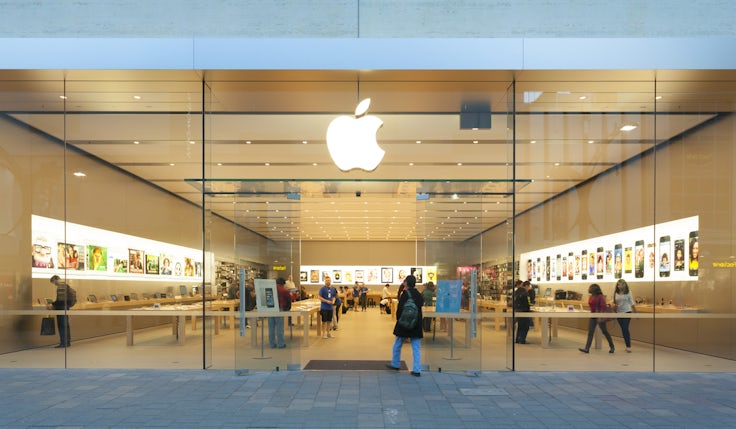Value of world’s biggest brands drops by 20%
Apple continues its reign as the world’s most valuable brand, according to Kantar’s BrandZ global top 100, but Amazon falls back to fourth.
 Apple has been crowned the world’s most valuable brand for the second year in a row, according to Kantar’s global BrandZ 2023 Top 100 ranking.
Apple has been crowned the world’s most valuable brand for the second year in a row, according to Kantar’s global BrandZ 2023 Top 100 ranking.
The tech giant’s success comes at a time when many brands have struggled to keep pace with the rapid growth they witnessed in the last few years. Because while, Apple is the top brand with a value of $880bn, with is down from $947bn last year, a 7% drop, and a sign that even the strongest brands have been hit by the current economic climate.
Indeed, the value of the entire ranking is down 20% this year. The total value of the top 100 brands now sits at $6.9trn, down from $8.7trn last year.
But at a time when all brands are struggling, Apple’s ability to justify premium prices has helped it stay on top, suggests Adele Jolliffe, head of brand consultants, insights, at Kantar.
“Success is not just about if you’re the most expensive brand in the market,” Jolliffe tells Marketing Week. “This is about the price you want to be able to charge relative to category average. Your perceptions and what people’s attitudes are to your brand have to match that and justify it.”
Google comes in second place this year, with a brand value of $558bn, a drop from last year’s $820bn (down 30%). Microsoft, which ranked fourth last year, has leapfrogged Amazon to become the third most valuable brand, at $502bn, but again this is a drop from last year’s $611bn (an 18% decline).
For Amazon, its position in fourth place signifies a significant fall from grace for the brand, which in 2021 hit the top spot for the third year running. Its brand value now sits at $469bn, a 34% drop from the $706bn recorded in 2022.

Elsewhere in the top 10, McDonald’s is the most valuable non-tech brand ($191bn, down 3%), followed by Visa ($169bn, down 11%), Tencent ($141bn, down 34%), Louis Vuitton ($125bn, no change), and MasterCard ($111bn, down 6%).
Coca-Cola comes in 10th, re-entering the top tier for the first time since 2015 with a brand value of $106bn. This is up 8% from $98bn last year, making it one of just 16 brands in 2023’s top 100 to grow at all in the past year.
Media and entertainment is the sector that sees the biggest decline in value in 2023, with a year-on-year decline of 32%. It is followed closely by retail, down 27%, and business technology and services, down 24%. Apparel fell by 21%, automotive and alcohol both dropped 13%, while telecom providers declined 10%.
Who fared well?

This year, food and beverages (down 3%), luxury (down 4%), and fast food (up 4%) fared best. Jolliffe links this to the “accessible treating” that comes within these categories for consumers.
The high performance of the luxury sector might seem somewhat at odds with this, but as Ellie Thorpe, director of Kantar BrandZ says, there’s no “silver bullet” for brands. Ultimately, it’s pricing power, whether at the premium end or lower scale, that provides “great value”.
Pepsi re-enters the top 100 this year in the 91st spot with a brand value of $18.8bn, a year-on-year increase of 17%. Colgate also joins the top 100 at 95 ($18.3bn, up 1%), alongside Sony at 99 ($17.8bn, N/A), and Pampers at 100 ($17.3bn, down 12%).
Shein, the Chinese online fast fashion retailer, enters the ranking for the first time too, jumping straight in at number 70. It hasn’t been a great year for sustainability, though, with only 2% of the top 100 being perceived as ‘leading’ in this area, according to Kantar.
Successful brands this year have created an “airbag” around them by working on building brand in the long term, says Jolliffe, which is key against “the amount of volatility” in the background. “Brand building is great for future demand, yes. But it plays another role: it creates a cushion and insulation for your business, which will help you through these really difficult times.”
As Thorpe adds: “We’ve seen the lingering effects of the pandemic, the war in Ukraine, the cost of living affecting millions around the world. Of course that’s going to impact brands and businesses.
“But despite some decline this year, we’ve seen that our top 100 is still worth 47% more than it was pre-pandemic and it’s still outperforming its longer-term growth trajectory.”
Methodology
Kantar’s BrandZ valuation process takes the financial value created by a brand in US dollars and multiplies it by brand contribution. The result is Brand Value – the dollar amount a brand contributes to the overall value of a corporation. Isolating and measuring this intangible asset reveals an additional source of shareholder value that otherwise would not exist.
That brand contribution is derived from consumer research that quantifies how much of the volume people purchase and how much of the price premium people pay can be attributed to brand equity, connecting what people think to what they do.
This year’s analysis involves 4.2 million consumer interviews covering 21,000 brands across 540 categories in 54 markets.








Comments